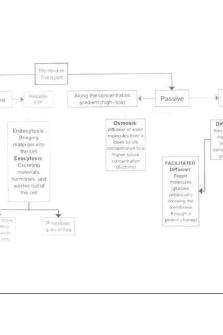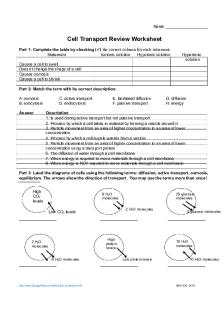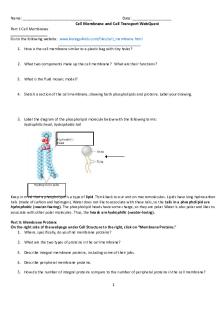BIOL 1000 Ex07 (Membrane Transport) Handout F20 PDF

| Title | BIOL 1000 Ex07 (Membrane Transport) Handout F20 |
|---|---|
| Course | General Biology 1 |
| Institution | Macomb Community College |
| Pages | 4 |
| File Size | 320.3 KB |
| File Type | |
| Total Downloads | 108 |
| Total Views | 170 |
Summary
Download BIOL 1000 Ex07 (Membrane Transport) Handout F20 PDF
Description
South Campus BIOL 1000 Lab Supplemental Lab Exercise 7: Membrane Transport Note: This handout is meant to be paired with the information in your lab manual and perhaps additional explanations from your instructor, as needed.
PART A: THE IMPORTANCE OF SURFACE AREA TO VOLUME RATIO Before proceeding, it may be useful to review related material from Chapter 4 in your textbook, particularly Figure 4.3. In this part of the lab, students normally explore the relationship between surface area and volume by using two different sizes of potato cubes. (Please note that potatoes are a starchy vegetable.) The potato cubes, once trimmed to the proper size as described in the lab manual, are placed into a beaker containing iodine reagent. As you learned in Exercise 6, when starch reacts with iodine reagent, a dark blue-black color results. Thus, a white potato cube is placed into the iodine reagent solution; during the incubation, the iodine reagent reacts with the starch in the potato. Therefore, any part of the potato that the iodine has soaked into turns blue-black. Once the (now black) potato cubes are removed from the beaker of iodine reagent, students cut them open to determine how much of the potato remained white. The data table (as associated equations) in your lab manual will walk you through how to use this measurement in calculations to figure out the ‘% Iodine Penetration’. In other words, what overall percentage of the potato was turned black? Remember, you will be comparing a smaller potato cube (“cell”) to a larger potato cube (“cell”) and relating the surface-area-to-volume ratio to the efficiency of (iodine) transport. You should complete the first three columns of your data table (Surface Area, Total Volume, and Surface Area to Volume Ratio) based on the sizes listed for the potato cubes. (Note: to calculate the surface area to volume ratio, simply divide the surface area by the volume; make the number a ratio by placing ‘:1’ after it.) In the column titled ‘Size of Light Portion (in mm)’ of your data sheet, please enter the following numbers: 3 mm (for the 5 mm cube) and 8 mm (for the 10 mm cube). You can use these numbers to calculate the volume of the light portion. Finally, use the equation below the table to calculate the ‘% Iodine Penetration’ in the last column. Which potato cube “cell” had a higher % Iodine Penetration (and thus more efficient transport): the 5 mm cube or the 10 mm cube?
PART B: SIMPLE DIFFUSION The topic of diffusion is covered in Chapter 5 of your textbook; it may be useful to review related material there before completing this part of the lab. There are two main goals for this portion of the lab: 1) to observe the process of diffusion and 2) to determine the relationship between molecular weight and rate of diffusion. In the lab, we meet these objectives by stabbing two different dye molecules (with different molecular weights) into an agar plate and watching as the color spreads out from the site of the initial stab: as the molecules undergo diffusion, they move down their concentration gradient, from their area of highest concentration (where they were stabbed into the plate) towards their lower concentration (initially, zero!) everywhere else on the plate. The picture below shows the diffusion of iodine (on the plate labeled A) and methylene blue (on the plate labeled B); both plates were stabbed with dye at the same time.
Given the molecular weights of iodine and methylene blue (listed on the data sheet for Part B in your lab manual), what conclusion can you draw about the relationship between molecular weight and the rate of diffusion? In other words: which molecule moved faster, the one with the lower molecular weight or the one with the higher molecular weight? Although the experimental details are different, you can also explore the relationship between molecular weight and the rate of diffusion by completing the McGraw-Hill Virtual Lab “Diffusion – Effect of Molecular Weight on the Rate of Diffusion in Air”, as directed by your instructor.
PART C: TONICITY The topics of osmosis, tonicity, and plasmolysis are covered in Chapter 5 of your textbook; it may be useful to review related material there before completing this part of the lab. In Part C1, carrots – a relatively sweet vegetable – are placed in different concentrations of sucrose, ranging from 0% sucrose (which is plain water) to 30% sucrose. The weight of each carrot is recorded before and after incubation in the solution. Any weight change of the carrot is due to osmosis as water moves into or out of the carrot. Using the mock data provided below, please calculate the weight change and % weight change (using the formulas provided in the lab manual) to complete the data table in your lab manual for Part C1. (Please note: for any carrot that lost weight, your calculated values for ‘weight change’ and ‘% weight change’ will be negative numbers.) Once you calculate the % weight change, plot your data on the graph paper provided on the data sheet, as directed in the lab manual. Use your calculations and graph to help you answer the questions in your lab manual. Sucrose Solution 0% 10% 20% 30%
Original Weight 3.5 g 3.40 g 4.3 g 3.7 g
Present Weight 3.65 g 3.40 g 4.0 g 2.9 g
The effects of osmosis can also be explored by completing the McGraw-Hill Virtual Lab “Osmosis – Movement of Water Across a Selectively Permeable Membrane,” as directed by your instructor. In Part C2, you will compare the appearance of Elodea cells in water versus in 10% sodium chloride. The pictures below (with notes added by the source) should help you complete the drawings and answer the questions on the data sheet in your lab manual.
Inage source: http://plato.acadiau.ca/courses/biol/reekie/1113/diffuse/Salt.htm In addition, complete the McGraw-Hill Virtual Lab “Osmosis – Tonicity in Elodea Cells,” as directed by your instructor.
PART D: DIFFUSION AND OSMOSIS ACROSS A SELECTIVELY PERMEABLE MEMBRANE The topics of diffusion, osmosis, and tonicity are covered in Chapter 5 of your textbook; it may be useful to review related material there before completing this part of the lab. In this part of the lab, students create a mock “cell” using dialysis tubing – a selectively permeable membrane – as a stand-in for the cell membrane. The “cell” is filled with a solution of starch and salt; the “cell” is then weighed before being placed in a beaker of plain water. The starch, salt, and water are not at equilibrium at the start of the experiment. Can you predict which way (into or out of the “cell”) each of the following substances should move: • • •
Water? Starch? Salt?
After a twenty-minute incubation, the movement of each molecule is assessed in the following ways: • •
•
Water: Weigh the “cell” again after the incubation and compare the present weight to its initial weight. Did the weight of the cell change? If so, how (increase or decrease) and why? Starch: Test the beaker water for the presence of starch by using iodine reagent. (You should be familiar with this test and its interpretation from Exercise 6: Molecules of Life. You can review the details of the starch test in that lab, if needed.) Note that the water in the beaker – not the solution inside the cell! – would be tested. We already know that the “cell” contains starch because we initially added it to the “cell”; we are trying to determine if the starch was able to cross the membrane to leave the “cell”. Salt: The reagent silver nitrate will be used to detect the presence of salt in a solution. Upon addition of silver nitrate to a solution containing the salt sodium chloride (NaCl), a cloudy white precipitate will form. Students observe this reaction by preparing a positive control before testing the beaker water. (A negative control is also performed by adding silver nitrate to distilled water; in this case, the solution remains clear.) Once again, please note that the water in the beaker – not the solution inside the cell! – would be tested for salt. We already know that the “cell” contains salt because we initially added it to the “cell”; we are trying to determine if the salt was able to cross the membrane to leave the “cell”.
Based on the mock data shared below, please complete your data sheet and answer the questions in your lab manual. • •
•
Original weight of “cell” = 10.7 grams; Present weight of “cell” (after incubation) = 11.5 grams Starch test, beaker water test appearance: amber/yellow (Note: You should be able to fill out the rest of the starch test table based on your knowledge and interpretation of this test from Exercise 6: Molecules of Life.) Salt test, beaker water test appearance: cloudy, white precipitate (Note: You should be able to fill out the rest of the salt test table based on the information provided about this test above.)
Although the experimental details are slightly different, there is a similar Virtual Lab within McGraw-Hill Connect that should held you understand this experiment. Please complete the Virtual Lab “Diffusion – Diffusion Across a Selectively Permeable Membrane”, as directed by your instructor....
Similar Free PDFs

Membrane Transport Flow Chart
- 1 Pages

Week 2 Membrane transport lab
- 6 Pages

Chapter 7 HW Membrane Transport
- 1 Pages

Biol 1000- LAB 2 Final
- 5 Pages

BIOL 1000 Class Notes copy
- 51 Pages
Popular Institutions
- Tinajero National High School - Annex
- Politeknik Caltex Riau
- Yokohama City University
- SGT University
- University of Al-Qadisiyah
- Divine Word College of Vigan
- Techniek College Rotterdam
- Universidade de Santiago
- Universiti Teknologi MARA Cawangan Johor Kampus Pasir Gudang
- Poltekkes Kemenkes Yogyakarta
- Baguio City National High School
- Colegio san marcos
- preparatoria uno
- Centro de Bachillerato Tecnológico Industrial y de Servicios No. 107
- Dalian Maritime University
- Quang Trung Secondary School
- Colegio Tecnológico en Informática
- Corporación Regional de Educación Superior
- Grupo CEDVA
- Dar Al Uloom University
- Centro de Estudios Preuniversitarios de la Universidad Nacional de Ingeniería
- 上智大学
- Aakash International School, Nuna Majara
- San Felipe Neri Catholic School
- Kang Chiao International School - New Taipei City
- Misamis Occidental National High School
- Institución Educativa Escuela Normal Juan Ladrilleros
- Kolehiyo ng Pantukan
- Batanes State College
- Instituto Continental
- Sekolah Menengah Kejuruan Kesehatan Kaltara (Tarakan)
- Colegio de La Inmaculada Concepcion - Cebu










